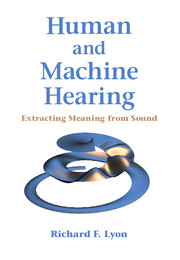Part V - Learning and Applications
Published online by Cambridge University Press: 28 April 2017
Summary
Part V Dedication: Max Mathews
This part is dedicated to the memory of Max Vernon Mathews (1926–2011), the father of computer music. Max had a decades-long focus on applications of computers to hearing and to music analysis, synthesis, and performance. His work on computer speech, music, and hearing started in the late 1950s at Bell Labs (Mathews, 1959, 1961, 1963). I had the opportunity to know Max at Stanford's CCRMA (Center for Computer Research in Music and Acoustics) where he worked for many years. When I taught my Human and Machine Hearing course at Stanford in 2010 (Psych 303, in affiliation with the Mind, Brain, and Computation center), Max came and audited the class once a week, climbing the stairs to the third floor with his hiking sticks. He invited me to his lab and explained the “coupled-form” filter that he was using for music synthesis; I subsequently adopted it as the basis for the digital implementation of my various cochlear filter models, so it figures prominently in earlier parts of the book.
In this part, we discuss the top two layers of our simple framework for machine hearing systems: types of systems that can be trained to address machine hearing applications, and ways that features can be extracted into a form suitable to be presented as inputs to such systems. We discuss several example applications, including ones on which we have published studies, and a survey of some others.
- Type
- Chapter
- Information
- Human and Machine HearingExtracting Meaning from Sound, pp. 417 - 418Publisher: Cambridge University PressPrint publication year: 2017



